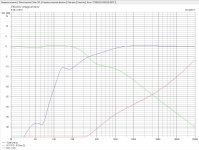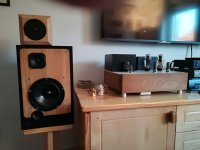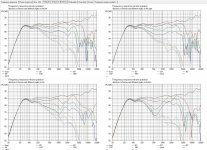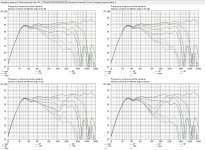Hello,
Couple of thoughts on this.
1. If RF pickup is what you have to worry about, a RF Zorbel on the ends of the speaker cable would likely fix that. ( 100nf in series with ~100ohm resistor.)
There is materiel on the web covering this if you are interested. Search for terminating speaker cables should get you started.
2. If you have a choice, keep the cables short. Every foot adds to the cables resistance, inductance, capacitance and RF pickup as well.
Couple of thoughts on this.
1. If RF pickup is what you have to worry about, a RF Zorbel on the ends of the speaker cable would likely fix that. ( 100nf in series with ~100ohm resistor.)
There is materiel on the web covering this if you are interested. Search for terminating speaker cables should get you started.
2. If you have a choice, keep the cables short. Every foot adds to the cables resistance, inductance, capacitance and RF pickup as well.
I try not to think about it 😉 I've experimented with a super tweeter, but it didn't really help me due to high frequency hearing loss, also I measured some comb filtering. I think a little high frequency boost would be better if needed and it would maintain the advantage of the point sourceScott,
How do you suggest a name for WAW (anachronistic acronym FAST) with supertweeter?
WAW&St ???
My ear also not for some super high frequencies.
But with supertweeter all frequencies above about 10-12kHz are slightly boosted, which gives much better total sound picture.
BTW, i am with TC9FD and 17 cm woofer in 25 l box.
But with supertweeter all frequencies above about 10-12kHz are slightly boosted, which gives much better total sound picture.
BTW, i am with TC9FD and 17 cm woofer in 25 l box.
I'm listening mostly off-axis.
My old Dynaudio D21/2 supertweeter was cut >20 kHz electrically.
0.52uF (film / foil ERO KP-1832) in series, then 17 ohm parallel to D21/2 for low attenuation.
This is best for my ear, after much experimentation
My old Dynaudio D21/2 supertweeter was cut >20 kHz electrically.
0.52uF (film / foil ERO KP-1832) in series, then 17 ohm parallel to D21/2 for low attenuation.
This is best for my ear, after much experimentation
Attachments
That's smooth. What xover are you using between woofer and wideband? It looks a bit like this S. Harsch XO which I'm experimenting with
Hello Henderson,
A ferrite bead just before the speaker would limit RF from the speakers voice coil and internal wiring, but would leave the entire length of the speaker cable able to act like an antenna. Most amps have some RF protection built in, but you certainly do not want RF getting into the feedback circuit.
A ferrite bead just before the speaker would limit RF from the speakers voice coil and internal wiring, but would leave the entire length of the speaker cable able to act like an antenna. Most amps have some RF protection built in, but you certainly do not want RF getting into the feedback circuit.
My first cheap tweak (KEF Q100) was a Würth 150 kHz ferrite in woofer cable.
The second was a 10nF 600V styroflex bypass:
An externally hosted image should be here but it was not working when we last tested it.
Last edited:
More Würth 150 kHz ferrites:
You know, I have VERY BIG problems with RF/EMI and...
An externally hosted image should be here but it was not working when we last tested it.
An externally hosted image should be here but it was not working when we last tested it.
An externally hosted image should be here but it was not working when we last tested it.
You know, I have VERY BIG problems with RF/EMI and...
That might help if cable RF resonance is an issue. Otherwise not. Reducing cable loop area is the first thing to do: twist!starkeyg said:1. If RF pickup is what you have to worry about, a RF Zorbel on the ends of the speaker cable would likely fix that. ( 100nf in series with ~100ohm resistor.)
No, that would achieve nothing. Ferrite bead near amplifier may help. Of course, ensure that both speaker wires go through the bead so the bead does not see audio current.Henderson said:Ferrite bead just before the speaker ?
No, that would not help. If he knows what he is talking about then he would have said to put beads where they may be useful (not everywhere).Basicly he said to put FB everywhere : inerconexion, speaker cables and grid wall cables... for RFI/EMC behavior.
Something strange is going on in that video test. The differences are a lot greater than they ought to be. After all some pros are using unshielded Cat5 cable for balanced interconnects and not having noise problems.By the way,
The Importance of Star-Quad Microphone Cable - Benchmark Media Systems, Inc.
The video is very very very interesting.
If both conductors in the braided cable are equally exposed to the interference field then they will cancel. However a braided cable is not as uniform as a twisted cable so there could be small differences.How is it as effective as twisting?
There need to be at least three conditions for this to be a problem with loudspeaker cables.
1] There needs to be an interference field.
2] The amplifier needs to be susceptible to interference at it's output terminals.
3] The speaker cable needs to be placed in a way to pick up voltage from that interference field.
Only if they are connected to a balanced receiver. In a twisted cable it will cancel due to the reversal of the magnetic field as the conductors rotate around one another (I'm sure we've been here before?)If both conductors in the braided cable are equally exposed to the interference field then they will cancel.
I should have added that to my list. It's had to predict how an amplifier's output stage and feedback loop will act as an input to radio frequency interference.
Jim Brown writes about amplifier outputs and interference.
Output Wiring is Important Too! It is well known, for example, that RF interference is often coupled
into the output stage of audio equipment – for example, the power amplifiers that feed loudspeakers
or headphones. There is always feedback around that output stage, so RF present at the
output will follow the feedback network to the input of a gain stage, where it will be detected and
amplified. This problem is made much worse when parallel wire cable (zip cord) is used to feed
the loudspeakers or headphones, and can usually be solved simply by replacing the zip cord with a
twisted pair of POC (plain ordinary copper). [Pseudo-scientific advertising hype for exotic cables
notwithstanding, it was shown nearly 30 years ago that #12 copper twisted pair (or #10 for very
long runs) is a nearly ideal loudspeaker cable.].................
As we will discuss later, the twisting of a pair greatly reduces the
level of RF that the wiring couples to circuitry.
Output Wiring is Important Too! It is well known, for example, that RF interference is often coupled
into the output stage of audio equipment – for example, the power amplifiers that feed loudspeakers
or headphones. There is always feedback around that output stage, so RF present at the
output will follow the feedback network to the input of a gain stage, where it will be detected and
amplified. This problem is made much worse when parallel wire cable (zip cord) is used to feed
the loudspeakers or headphones, and can usually be solved simply by replacing the zip cord with a
twisted pair of POC (plain ordinary copper). [Pseudo-scientific advertising hype for exotic cables
notwithstanding, it was shown nearly 30 years ago that #12 copper twisted pair (or #10 for very
long runs) is a nearly ideal loudspeaker cable.].................
As we will discuss later, the twisting of a pair greatly reduces the
level of RF that the wiring couples to circuitry.
Something strange is going on in that video test. The differences are a lot greater than they ought to be. After all some pros are using unshielded Cat5 cable for balanced interconnects and not having noise problems.
The precision of the twist in CAT5 is far greater than it is in most audio cables, and that's what helps the interference to be rejected by a twisted pair. Screening reduces electrostatic interference, but the twist handles the EMI type interference.
IME, star quad does reject an awful lot of interference, at the cost of extra capacitance and the pain in the rear of not having a drain wire. But, having a drain wire means the cable doesn't work right, so you win the battle and lose the war. The performance benefit of star quad is significant.
What is it good for?My first cheap tweak (KEF Q100) was a Würth 150 kHz ferrite in woofer cable.
An externally hosted image should be here but it was not working when we last tested it.
Best regards!
- Status
- Not open for further replies.
- Home
- Design & Build
- Parts
- Belden DIY audio cables




